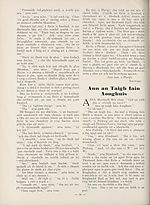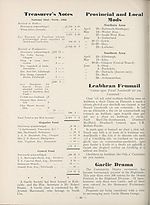An Comunn Gàidhealach Publications > Gaidheal > Volume 49--51, January 1954--December 1956
(267) Page 37
Download files
Complete book:
Individual page:
Thumbnail gallery: Grid view | List view

5 S-
“Nach greas iad orra ach an gabh mi aon
Idaorach a bhios iomraiteach!”
f Bha grunnan a nis air tighinn a steach agus
iarsa fear dhiubh, “Sin an seorsa daoraich a
ghabh thu an oidhche a chaidil thu air a’
ghlasaich ann an Inbhir-Uige. ’ ’
Arsa fear na ciiil-mhona, “Cha b’e smuid a
chuir a chadal e an oidhche sin ach sgleog bho
Ghallach anns an t-sabaid mhoir.
“Cha tug agus cha d’fhuair mise sgleog, ach
fhuair na Gallaich barrachd air na thug iad.
Thug iad na cuiltean orra an uair a thoisich
Aonghus Greum a Siadar a’ sadadh nam
baraillean sgadain ’nam measg!’’
! “Chuala mi sin,’’ arsa cuid-eigin, “ach a
if bheil e fior?’’
! “Chan ’eil duine sam bith,’’ thubhairt
I 1 Padraig, ‘ ‘ a chunnaic ‘ Clach Aonghuis Ghreum, ’
| a tha an cois an rathaid-mhoir eadar Barabhas
I I agus Steornabhagh, nach creid gun tilgeadh am
1 1 fear a chairich a’ chlach ud far a bheil i baraille
I : sgadain thairis air a ghualainn. Aig a’ chilirt
c bha an Greumach air a mhionnan agus cha
I ; b’urrainn dha a radh an e baraillean no leth-
| j bharaillean a bha e a’ tilgeadh, an robh iad
i lan no falamh. Tha e cho furasda dhomhsa a
1 chreidsinn ri gu bheil mi fhein a’ dol a
; dh’fhaighinn cruin Di-haoine, agus nach ’eil
J an ath Dhi-haoine ach tiota air falbh. Tha mi
I ; a’ dol dhachaigh leis an naidheachd gu Catriona
I : Liath. Ach, mar a thubhairt am bard, ‘Tha
; dorainn ceangailt’ ri gach maith’. Chan 'eil
1 fhios nach dean Murchadh, mo bhrathair, a
tha ’na bhantraich, an donas leis a’ chrim!’’
A. M.
Reviews
“A History of Scotland,’’ Book I. By
I. M. M. Macphail. (Edward Arnold,
London, 256pp., 6/6).
Dr. Iain Macphail, who is Principal Teacher
of History in Clydebank High School, has had
published the first volume of a two-volume
“History of Scotland for Schools.’’ Book I
covers the period from the earliest times to 1747.
There are several very good short histories of
Scotland already available, but this new one
has special features which will, we hope,
commend it, not only to school-teachers, but to
the general public, and especially all interested
in the Highlands. In this book much greater
prominence is given to the history of Celtic
Scotland, and the author, himself a Highlander,
has not been sparing in the use of Gaelic names,
terms, and phrases—and all accurately used and
correctly spelt. While political history takes
up most of the narrative, considerable space is
devoted to economic and social history, while
there are frequent references to the art and
literature of Scotland. In the chapter on ‘ ‘The
End of the Middle Ages,’’ Dr. Macphail,
writing of the reigns of James IV and James V
as “The Golden Age of Scottish Literature,’’
says, “It would be wrong, however, to think
that the Scots had no literature before this time.
We must remember that up to the sixteenth
century probably the majority of Scotsmen
still spoke Gaelic.’’ He goes on to mention
the Old Gaelic manuscripts, such as the Book
of Deer, the Book of the Dean of Lismore, and
the ancient tales and ballads of Gaelic Scotland.
The chapter on “The Highlands and Islands
under James VI’ ’ is of special value. The book
is well supplied with illustrations, maps, and
plans, and a useful Time Chart. There is an
excellent index. We look forward to Book II.
“Clan MacLeod Magazine,’’ 1955. Edited
by the Rev. Donald Mackinnon (Published
by the Clan Macleod Society).
This well-produced magazine makes its
annual appearance, and, while of interest
primarily to the clansfolk for whom it is chiefly
intended, contains much that many others will
be glad to read. The indefatigable Chief,
Dame Flora Macleod of Macleod, having
several times toured Canada and the U.S.A.,
has recently been to New Zealand and Australia,
and she, more than any other person, has given
the idea of Chiefship and Clanship a new
importance in the modern world. Brenda
Macleod writes about ‘ 'A Skye Chief at Home, ’ ’
the Chief being Iain Breac who became Chief
in 1664, “a patron of the arts,’’ who gathered
round him the best pipers, harpers, and bards
of the day. On his death, a new regime began.
The change forms the theme of the Blind
Harper’s ‘ ‘bran mor. ’ ’ Mr. Alick Morrison
writes informatively about “The Old Macleods
of Berneray, Harris.’’ There are genealogical
notes and queries, clan society news, obituaries,
and a “Young Clansfolk’s Page’’ with a Cross¬
word Puzzle.
Cha ghleidh thu clach anns .a’ chladach.
Chi duine acrach fada uaithe.
Cha diult peann breug.
* * * *
A’ deanamh cuain mhoir de chaolas cumhang.
* * *
Tha an uaisle mar a chumar i.
Tha mi na’s eolaiche air coille na a bhith fo
eagal na caillich-oidhche.
— 37 —
“Nach greas iad orra ach an gabh mi aon
Idaorach a bhios iomraiteach!”
f Bha grunnan a nis air tighinn a steach agus
iarsa fear dhiubh, “Sin an seorsa daoraich a
ghabh thu an oidhche a chaidil thu air a’
ghlasaich ann an Inbhir-Uige. ’ ’
Arsa fear na ciiil-mhona, “Cha b’e smuid a
chuir a chadal e an oidhche sin ach sgleog bho
Ghallach anns an t-sabaid mhoir.
“Cha tug agus cha d’fhuair mise sgleog, ach
fhuair na Gallaich barrachd air na thug iad.
Thug iad na cuiltean orra an uair a thoisich
Aonghus Greum a Siadar a’ sadadh nam
baraillean sgadain ’nam measg!’’
! “Chuala mi sin,’’ arsa cuid-eigin, “ach a
if bheil e fior?’’
! “Chan ’eil duine sam bith,’’ thubhairt
I 1 Padraig, ‘ ‘ a chunnaic ‘ Clach Aonghuis Ghreum, ’
| a tha an cois an rathaid-mhoir eadar Barabhas
I I agus Steornabhagh, nach creid gun tilgeadh am
1 1 fear a chairich a’ chlach ud far a bheil i baraille
I : sgadain thairis air a ghualainn. Aig a’ chilirt
c bha an Greumach air a mhionnan agus cha
I ; b’urrainn dha a radh an e baraillean no leth-
| j bharaillean a bha e a’ tilgeadh, an robh iad
i lan no falamh. Tha e cho furasda dhomhsa a
1 chreidsinn ri gu bheil mi fhein a’ dol a
; dh’fhaighinn cruin Di-haoine, agus nach ’eil
J an ath Dhi-haoine ach tiota air falbh. Tha mi
I ; a’ dol dhachaigh leis an naidheachd gu Catriona
I : Liath. Ach, mar a thubhairt am bard, ‘Tha
; dorainn ceangailt’ ri gach maith’. Chan 'eil
1 fhios nach dean Murchadh, mo bhrathair, a
tha ’na bhantraich, an donas leis a’ chrim!’’
A. M.
Reviews
“A History of Scotland,’’ Book I. By
I. M. M. Macphail. (Edward Arnold,
London, 256pp., 6/6).
Dr. Iain Macphail, who is Principal Teacher
of History in Clydebank High School, has had
published the first volume of a two-volume
“History of Scotland for Schools.’’ Book I
covers the period from the earliest times to 1747.
There are several very good short histories of
Scotland already available, but this new one
has special features which will, we hope,
commend it, not only to school-teachers, but to
the general public, and especially all interested
in the Highlands. In this book much greater
prominence is given to the history of Celtic
Scotland, and the author, himself a Highlander,
has not been sparing in the use of Gaelic names,
terms, and phrases—and all accurately used and
correctly spelt. While political history takes
up most of the narrative, considerable space is
devoted to economic and social history, while
there are frequent references to the art and
literature of Scotland. In the chapter on ‘ ‘The
End of the Middle Ages,’’ Dr. Macphail,
writing of the reigns of James IV and James V
as “The Golden Age of Scottish Literature,’’
says, “It would be wrong, however, to think
that the Scots had no literature before this time.
We must remember that up to the sixteenth
century probably the majority of Scotsmen
still spoke Gaelic.’’ He goes on to mention
the Old Gaelic manuscripts, such as the Book
of Deer, the Book of the Dean of Lismore, and
the ancient tales and ballads of Gaelic Scotland.
The chapter on “The Highlands and Islands
under James VI’ ’ is of special value. The book
is well supplied with illustrations, maps, and
plans, and a useful Time Chart. There is an
excellent index. We look forward to Book II.
“Clan MacLeod Magazine,’’ 1955. Edited
by the Rev. Donald Mackinnon (Published
by the Clan Macleod Society).
This well-produced magazine makes its
annual appearance, and, while of interest
primarily to the clansfolk for whom it is chiefly
intended, contains much that many others will
be glad to read. The indefatigable Chief,
Dame Flora Macleod of Macleod, having
several times toured Canada and the U.S.A.,
has recently been to New Zealand and Australia,
and she, more than any other person, has given
the idea of Chiefship and Clanship a new
importance in the modern world. Brenda
Macleod writes about ‘ 'A Skye Chief at Home, ’ ’
the Chief being Iain Breac who became Chief
in 1664, “a patron of the arts,’’ who gathered
round him the best pipers, harpers, and bards
of the day. On his death, a new regime began.
The change forms the theme of the Blind
Harper’s ‘ ‘bran mor. ’ ’ Mr. Alick Morrison
writes informatively about “The Old Macleods
of Berneray, Harris.’’ There are genealogical
notes and queries, clan society news, obituaries,
and a “Young Clansfolk’s Page’’ with a Cross¬
word Puzzle.
Cha ghleidh thu clach anns .a’ chladach.
Chi duine acrach fada uaithe.
Cha diult peann breug.
* * * *
A’ deanamh cuain mhoir de chaolas cumhang.
* * *
Tha an uaisle mar a chumar i.
Tha mi na’s eolaiche air coille na a bhith fo
eagal na caillich-oidhche.
— 37 —
Set display mode to:
![]() Universal Viewer |
Universal Viewer | ![]() Mirador |
Large image | Transcription
Mirador |
Large image | Transcription
| An Comunn Gàidhealach > An Comunn Gàidhealach Publications > Gaidheal > Volume 49--51, January 1954--December 1956 > (267) Page 37 |
|---|
| Permanent URL | https://digital.nls.uk/127175625 |
|---|
| Description | This contains items published by An Comunn, which are not specifically Mòd-related. It includes journals, annual reports and corporate documents, policy statements, educational resources and published plays and literature. It is arranged alphabetically by title. |
|---|
| Description | A collection of over 400 items published by An Comunn Gàidhealach, the organisation which promotes Gaelic language and culture and organises the Royal National Mòd. Dating from 1891 up to the present day, the collection includes journals and newspapers, annual reports, educational materials, national Mòd programmes, published Mòd literature and music. |
|---|---|
| Additional NLS resources: |
|

